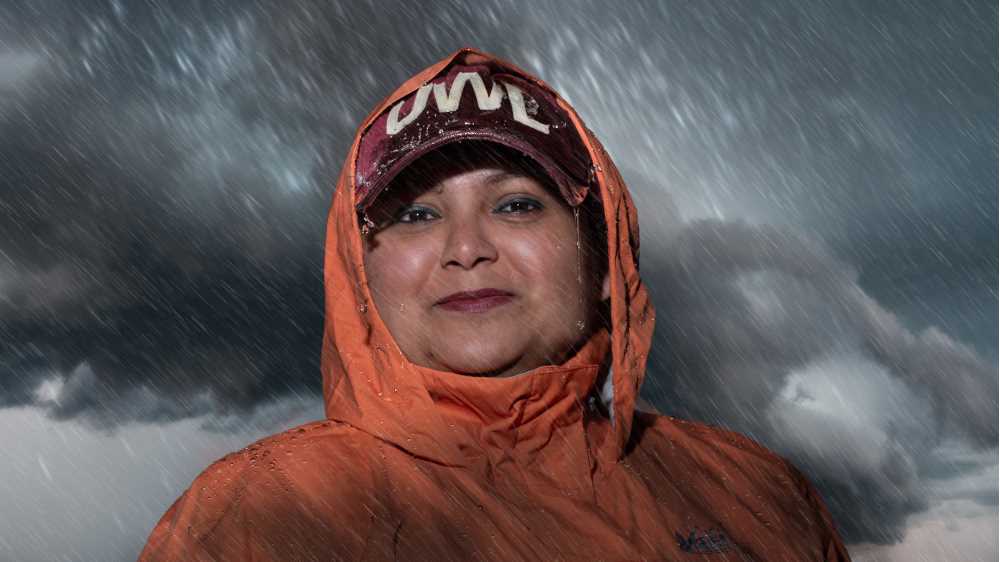Posted 1:31 p.m. Friday, June 27, 2025

UWL researcher uses artificial intelligence to help protect vulnerable communities from the world’s most dangerous storms
When extreme weather strikes, it can change lives in an instant. That’s why Rupsa Bhowmick, assistant professor of Geography and Environmental Science at UW-La Crosse, is using artificial intelligence (AI) to make forecasting faster, smarter, and more accurate — especially for communities most at risk.
Bhowmick’s research focuses on predicting tropical cyclones in the Southwest Pacific, a region where island nations like Fiji, Vanuatu, and New Caledonia are increasingly vulnerable to destructive storms fueled by warming oceans. She’s also applying these methods to the U.S. Midwest, where extreme weather like floods, blizzards and tornadoes pose growing threats.
Whether across the globe or close to home, Bhowmick’s mission is clear: improve forecasts to save lives.
“Extreme weather events can turn our lives upside down in seconds,” Bhowmick says. “Through research, we can improve forecasting, better communicate risk, and design infrastructure that’s ready for what’s coming.”
A personal drive: From India’s Bay of Bengal to global forecasting
Bhowmick’s passion for weather research began with personal experience. Growing up near the Bay of Bengal in India, she witnessed firsthand the devastating impact of cyclones and flooding.
In her community, outcomes often depend on economic status. Families with means could recover quickly. Those living in low-income or slum districts faced far greater challenges—including displacement and permanent loss of homes.
“Even as a child, I wondered why the impact of the same storm could vary so much from one region to the next,” she recalls. “That’s what led me to study geography and weather—to find answers that could help people.”
As a graduate student, Bhowmick turned her attention to the Southwest Pacific, a cyclone-prone region where many communities lack the resources to recover after disasters. Her work focuses on developing machine learning methods to classify and predict cyclone intensity evolution—especially before landfall—by integrating supervised learning with geospatial diagnostics. This work resulted in a scalable and interpretable framework for probabilistic intensity forecasting, aimed at supporting climate-resilient hazard planning in vulnerable regions.
She also studies extreme cyclone risk estimation, helping map where extreme cyclones - Category 4 and beyond – are likely to strike, carrying catastrophic impacts. Additionally, she studies how warmer ocean temperatures are making these extreme storms stronger and more frequent.
AI for cyclone forecasting
A major breakthrough in Bhowmick’s research is her use of machine learning—a subset of AI—to improve cyclone prediction, especially for rapidly intensifying (RI) cyclones.
These storms strengthen dramatically in a short time, often catching communities off guard. Traditional weather models struggle to predict RI events because they involve complex interactions between multiple environmental factors.
Bhowmick’s machine learning models—such as decision trees, random forests, and XGBoost—analyze massive datasets of cyclone behavior alongside environmental conditions like ocean heat, humidity, and wind patterns. The goal: spot patterns and correctly identify RI events earlier, giving people more time to prepare.
“Machine learning can process many interacting variables at once, helping to avoid issues like multicollinearity while uncovering complex, non-linear patterns in the data” she explains. “That’s what makes it so powerful for predicting rapid intensification, which is still one of the biggest challenges in weather forecasting.”
Bringing research home: extreme weather in the Midwest

While her early work focused on tropical regions, Bhowmick is now applying her expertise to the Midwestern U.S., where communities face a different kind of storm: extra-tropical cyclones.
These storms do not form over warm ocean waters like tropical cyclones, but rather from the interaction of contrasting air masses along the jet stream, particularly between October and March. They can bring intense winds, heavy snow, thunderstorms, and even dangerous waves on the Great Lakes. Some evolve into 'bomb cyclones,' rapidly intensifying within 24 hours and producing intense winds and blizzard conditions.
Bhowmick is using machine learning to study these storms’ behavior, including their intensity, speed, frequency, and how long-term oceanic-atmospheric trends may influence them.
“Whether it’s a tropical or extra-tropical cyclone, the impact can be devastating if people aren’t warned in time,” she says. “My research aims to give communities the tools they need to stay safe.”
Teaching the next generation
In addition to her research, Bhowmick teaches physical geography and climatology courses at UWL and is actively working to involve students in her projects. She sees education as a critical part of the solution—training the next generation to use data and technology to improve public safety.
“Now my training inspires me to translate this knowledge into action,” she says. “I want students to learn how to build these models, analyze extreme weather, and apply their skills to help communities prepare for the worst.”
So — can extreme weather be predicted?
The answer is yes, though it’s not easy.
Predicting extreme weather remains one of science’s toughest challenges. But thanks to advances in high-resolution data, machine learning, and deep learning-based forecasting and prediction techniques, researchers like Bhowmick are making real progress.
“This research is all about people,” she says. “With better forecasts and more resilient infrastructure, we can reduce loss—of property and, more importantly, of life.”
